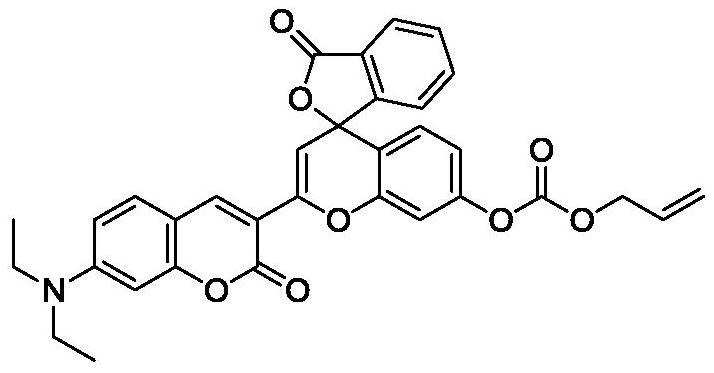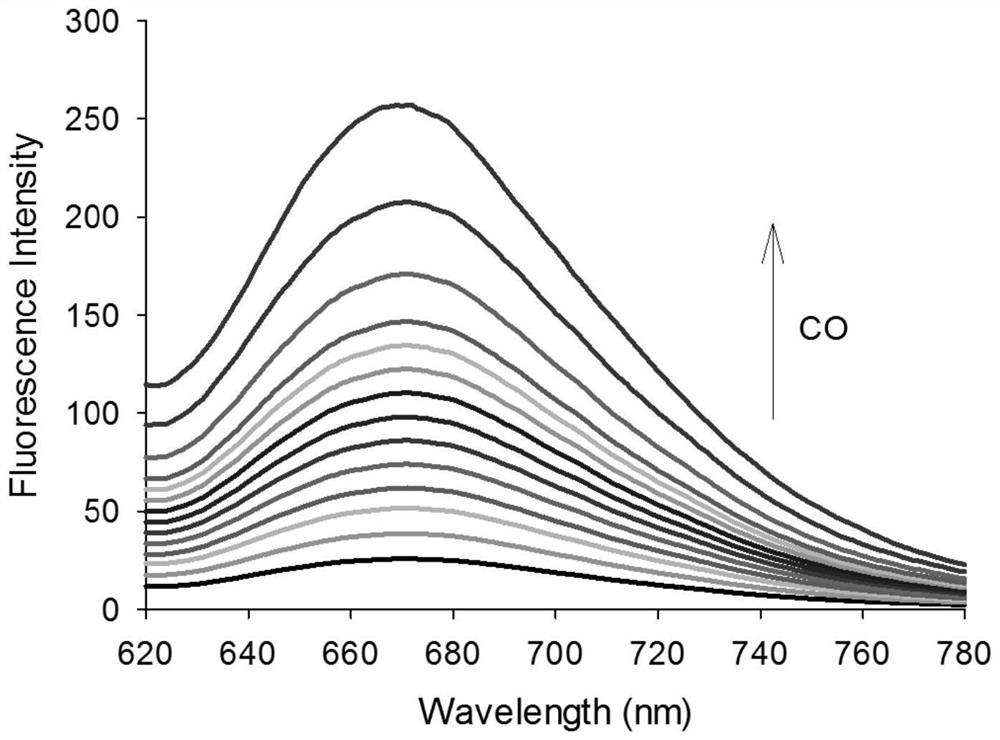Preparation and Application of Pyran-coumarin-Based Fluorescent Probe for Carbon Monoxide
A carbon monoxide, fluorescent probe technology, applied in the field of fluorescent probes, can solve problems such as long response time, short analysis wavelength, and reduced probe sensitivity
- Summary
- Abstract
- Description
- Claims
- Application Information
AI Technical Summary
Problems solved by technology
Method used
Image
Examples
Embodiment 1
[0025] Synthesis of fluorescent probes
[0026] Synthetic route such as figure 1 . Synthesis of compound CP-OH: In a 100mL round bottom flask, 3-acetyl-7-diethylaminocoumarin (0.39g, 1.5mmol) and 2-(2,4-dihydroxybenzoyl ) benzoic acid (0.39g, 1.5mmol) was dissolved in 8mL of methanesulfonic acid, and the reaction mixture was stirred at 90°C for 12h to stop the reaction, then the reaction mixture was cooled to room temperature, poured into a beaker containing 50g of ice water, and immediately Add 0.8mL of 70% perchloric acid, a blue-green solid precipitates immediately, stand still for 2h, filter, wash the solid with 10mL of ice water, dry, the crude product is mixed with CH at a volume ratio of 20:1 2 Cl 2 / CH 3 OH eluent was subjected to column chromatography to obtain a blue-green solid compound (0.52 g, yield 60%), which was compound CP-OH.
[0027] Synthesis of CO fluorescent probe (CP-CO): In a 100mL round bottom flask, the compound CP-OH (0.58g, 1.0mmol), allyl chlo...
Embodiment 2
[0029] Fluorescent probe and CO solution preparation
[0030] Preparation of probe solution: Weigh a certain amount of probe and dissolve it in dimethyl sulfoxide to make 1×10 -4 M probe solution. At the same time, weigh a certain amount of PdCl 2 Dissolved in twice distilled water to make 1×10 -4 stock solution of M. Preparation of CO solution: Dissolve a certain amount of CORM-3 in twice-distilled water, transfer it to a 500mL volumetric flask, add water to the mark, and obtain a concentration of 1.0×10 -3 mol L -1 CORM-3. Divide 1.0×10 -3 mol L -1 The CORM-3 solution was gradually diluted to obtain 2.0 x 10 -4 -1.0×10 -5 mol L -1 CORM-3 aqueous solution. Mix 1.0 mL of probe stock solution, 1.0 mL of PdCl 2 The stock solution and 1.0mL of CORM-3 aqueous solution were added to a 10mL volumetric flask, and after constant volume with buffer solution, a concentration of 1.0×10 - 5 mol L -1 fluorescent probe and PdCl 2 , 2.0×10 -5 -1.0×10 -6 mol L -1 CO mixed w...
Embodiment 3
[0032] Measurement of Fluorescence Spectrum of Fluorescent Probe Interaction with CO
[0033] figure 2 For the fluorescence spectrum of the fluorescent probe interacting with CO, the fluorescent probe and Pd 2+ The concentration of CO is 10 μM, and the CO concentration is: 0, 1.0, 2.0, 3.0, 4.0, 5.0, 6.0, 7.0, 8.0, 9.0, 10, 12, 15, 20 μM. The excitation wavelength is fixed at 600nm, and the emission wavelength range is 620-780nm. The slit width is 5.0 nm / 5.0 nm, and the fluorescence measurement instrument used is a Hitachi F4600 fluorescence spectrophotometer. From figure 2 It can be seen that due to the quenching effect of allyl formate, the addition of the fluorescent probe to Pd 2+ After that, there is no obvious near-infrared emission peak at the near-infrared (670nm); while adding Pd 2+ After and CO, an obvious near-infrared emission peak appeared at 670 nm. This is because Pd 2+ First reduced to Pd by CO 0 , which subsequently mediates the Tsuji-Trost reaction,...
PUM
 Login to View More
Login to View More Abstract
Description
Claims
Application Information
 Login to View More
Login to View More - R&D
- Intellectual Property
- Life Sciences
- Materials
- Tech Scout
- Unparalleled Data Quality
- Higher Quality Content
- 60% Fewer Hallucinations
Browse by: Latest US Patents, China's latest patents, Technical Efficacy Thesaurus, Application Domain, Technology Topic, Popular Technical Reports.
© 2025 PatSnap. All rights reserved.Legal|Privacy policy|Modern Slavery Act Transparency Statement|Sitemap|About US| Contact US: help@patsnap.com



